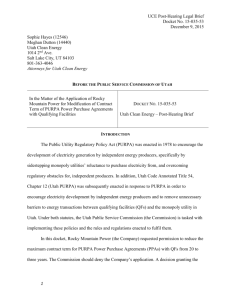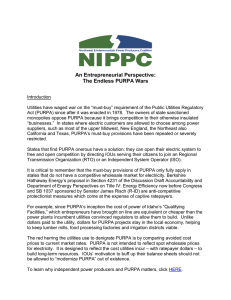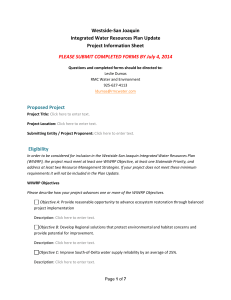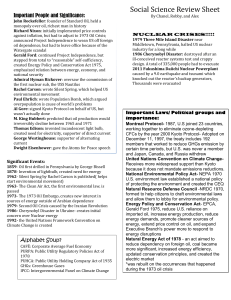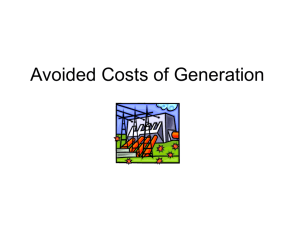Rocky Mountain Power Post Hearing Brief
advertisement
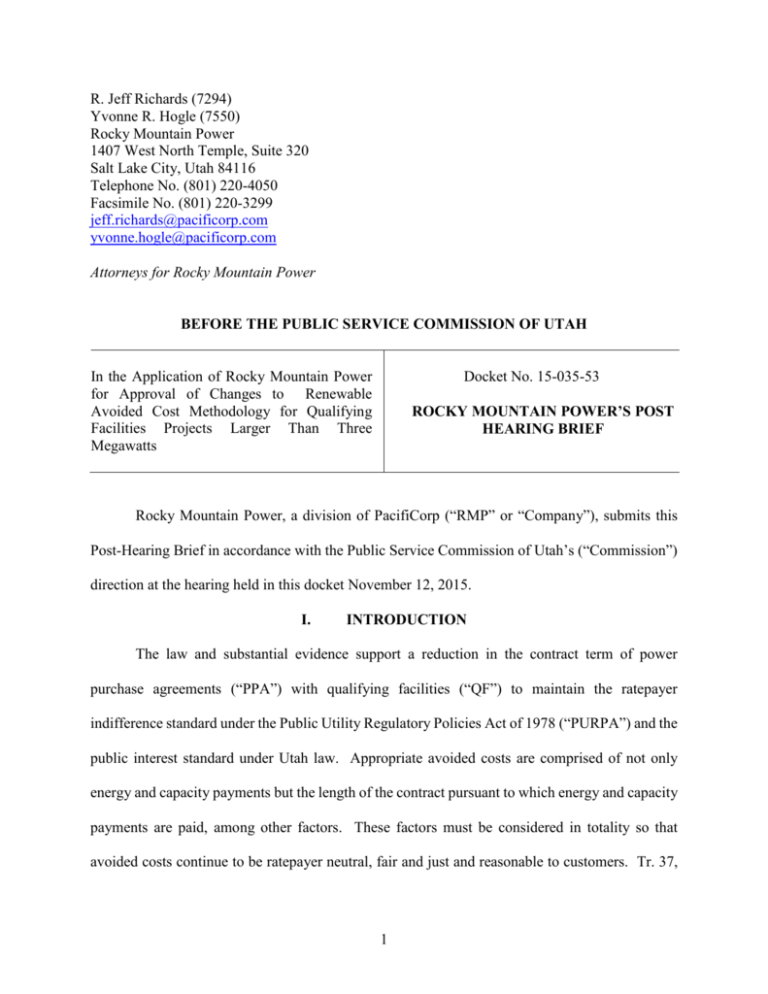
R. Jeff Richards (7294) Yvonne R. Hogle (7550) Rocky Mountain Power 1407 West North Temple, Suite 320 Salt Lake City, Utah 84116 Telephone No. (801) 220-4050 Facsimile No. (801) 220-3299 jeff.richards@pacificorp.com yvonne.hogle@pacificorp.com Attorneys for Rocky Mountain Power BEFORE THE PUBLIC SERVICE COMMISSION OF UTAH In the Application of Rocky Mountain Power for Approval of Changes to Renewable Avoided Cost Methodology for Qualifying Facilities Projects Larger Than Three Megawatts Docket No. 15-035-53 ROCKY MOUNTAIN POWER’S POST HEARING BRIEF Rocky Mountain Power, a division of PacifiCorp (“RMP” or “Company”), submits this Post-Hearing Brief in accordance with the Public Service Commission of Utah’s (“Commission”) direction at the hearing held in this docket November 12, 2015. I. INTRODUCTION The law and substantial evidence support a reduction in the contract term of power purchase agreements (“PPA”) with qualifying facilities (“QF”) to maintain the ratepayer indifference standard under the Public Utility Regulatory Policies Act of 1978 (“PURPA”) and the public interest standard under Utah law. Appropriate avoided costs are comprised of not only energy and capacity payments but the length of the contract pursuant to which energy and capacity payments are paid, among other factors. These factors must be considered in totality so that avoided costs continue to be ratepayer neutral, fair and just and reasonable to customers. Tr. 37, 1 ll. 23-25; Tr. 38, ll. 24-25; and Tr. 39, ll.1-14, and ll. 18-23. A 20-year contract term unnecessarily exposes customers to unreasonable fixed-price risks considering the limitless number, and magnitude of, contracts the Company must and continues to execute in this jurisdiction. Clements Dir./4, ll. 68-70. While the Company acknowledges its “must purchase” obligation under PURPA, the latitude this Commission has in implementing PURPA allows it to consider local conditions and needs, so long as the final implementation plan is consistent with statutory requirements.1 This flexibility allows the Commission to mitigate the harm that the current 20-year fixed contract term imposes on customers by reducing it to three years. II. A. ARGUMENT The Commission Has the Authority and Discretion to set an Appropriate Contract Length for Power Purchase Agreements; Neither the Public Utility Regulatory Policies Act of 1978 nor Implementing Regulations Expressly Specify a Length for QF Contracts. Under PURPA, the Company is required to purchase electricity offered by QFs at rates that are just and reasonable to customers and are no greater than the incremental cost the Company would otherwise incur to generate the energy itself or purchase it from another party. 2 The incremental cost is the maximum price the Company is obligated to pay to ensure ratepayer indifference, i.e., that customers do not pay any more for energy supplied by a QF than they would for energy generated by the Company itself or purchased from another source. 3 Although PURPA’s federal mandate requires the Company to purchase QF power, it gives states a wide See FERC v. Mississippi, 456 U.S. 742, 767 (1982) (explaining that PURPA “establishes a program of cooperative federalism that allows States, within limits established by federal minimum standards, to enact and administer their own regulatory programs, structured to meet their own particular needs.”). 2 Pub L. No. 95-617, 92 Stat. 3117 (1978). 3 Federal Energy Regulatory Commission’s (“FERC”) Notice of Proposed Rulemaking, Administrative Determination of Avoided Costs, Rates for Sale of Power to Qualifying Facilities, and Interconnection Facilities, Docket No. RM886-00; IV F.E.R.C. Statutes and Regulations (CCH) ¶ 32,457 (1988). 1 2 degree of latitude to implement PURPA with respect to setting avoided costs rates, as well as approving the contract terms of PPAs between utilities and QFs, as has been recognized by this Commission.4 At the hearing, Mr. Clements and Division witness Mr. Peterson testified about states’ ability to not only set an appropriate contract length but to reduce contract lengths to protect the ratepayer indifference standard. Tr. 108, ll. 6-22. For example, Mr. Clements referenced the Idaho Public Utilities Commission decision affirming its August 2015 order indicating that it was “reasonable and consistent with PURPA that the standard IRP contract be reduced from 20 years to two years.”5 The Idaho commission made its findings based, in part, on the same undisputed evidence presented by the Company in this case. Mr. Clements also referenced the Exelon Wind 1, LLC Fifth Circuit court opinion. Tr. 108, ll. 18-22. In that case, the Fifth Circuit court held that the Public Utility Commission of Texas had the discretion to determine the specific parameters for when a wind farm can form a legally enforceable obligation which requires rates set … years in advance.6 In that case, the court upheld the Texas Commission’s decision to limit the long-term pricing available through legally enforceable obligations to wind farms that could deliver firm power.7 Finally, Mr. Peterson also testified that the state of Washington limits its PPA contract length to five years. Tr. 144, ll. 7-10. In contrast, outside of claiming that reducing the contract length was contrary to PURPA 4 Order on Phase II, Docket No. 12-025-100, p. 6 (August 16, 2013); In the Matter of the Implementation of Rules Governing Cogeneration and Small Power Production in the State of Utah, Docket No. 80-999-06, Report and Order (March 14, 1985), pp. 37-38 (providing small power producers with fixed fuel cost the option of a 35 year (rather than 20) contract “will necessitate a recalculation of the capacity payments for such an extended contract, which the Commission understands will be at a higher price”). 5 In the Matter of Rocky Mountain Power Company’s Petition to Modify Terms and Conditions of PURPA Purchase Agreements, Case No. PAC-E-15-03, Order No. 33419, p. 27. 6 Exelon Wind 1, LLC, 766 F.3d 380 (5th Cir. 2014). 7 Id. 3 and of “questionable” legality,8 no party provided a specific reference to PURPA statutes or implementing regulations expressly prohibiting a state’s ability to set an appropriate contract length or reduce the contract length.9 In fact, during cross examination and in response to Commission questions, Mr. Beach acknowledged that when the California Public Utilities Commission suspended standard offer contracts for approximately 20 years (from 1986 to 2003) as a result of the limitless number and magnitude of QF PPAs that were signed during a short three-to-four year period, the California commission implemented the “must purchase” obligation under PURPA by administering one year PURPA contracts. Tr. 221, ll. 14-20; Tr. 229, ll. 5-7 Like the state commissions referenced above, this Commission clearly has the authority and discretion to reduce the current 20-year fixed contract length to three years as proposed by the Company. B. A Reduction of the Contract Length is Not Contrary to PURPA or State Policy; Other Factors Exist that Continue to Encourage the Development of Renewable Resources. A reduction in the contract term of QF PPAs is neither contrary to PURPA or state policy to encourage the development of renewable energy resources. First, PURPA’s goal to encourage the development of alternate generation includes statutory incentives such as 1) the exemption of QFs from the Federal Power Act and other requirements that would otherwise apply and might act as regulatory barriers; and 2) putting QFs on a level playing field by guaranteeing that all output they want to sell will be bought at a “reasonable” price, the same price the utility would pay for its own generation or for power it can purchase from another source. Tr. 110, ll. 7-24. These incentives are still in place and will continue to encourage the development of renewable resources. 8 R. Thomas Beach Dir., Executive Summary. In direct testimony, Mr. Beach discussed a case in which the North Carolina Commission found its 15 year contract term more appropriate than the shorter ten year contract term proposed by the utilities. Beach Dir. 15/ ll. 286-307. However, no evidence from that case was presented to determine whether the facts in that case were in any way similar to those in this case. 9 4 Second, with respect to state policy, the ownership of Renewable Energy Credits (“RECs”) by QFs serves, in part, to encourage renewable energy development, as indicated by this Commission.10 In addition, similar to the exemption of QFs from federal laws, QFs are also largely exempt from state regulatory laws which further serves to encourage the development of renewable energy. Tr. 110, ll. 7-24 The Company’s motives in this case were questioned and even assumed to be anticompetitive by some parties in this case. Beach Dir./Executive Summary They claim the Company has a hidden agenda to halt the development of renewable energy resources in this state. Tr. 61, ll. 18 and Tr. 62, ll. 1-2 This is simply not true. Mr. Clements testified that QF contracts are modeled as part of the Company’s net power costs and that the Company recovers most if not all of its costs related to these contracts through rate cases and its energy balance account. Tr. 62, ll. 3-23. The Company also supports a variety of programs that promote and encourage the development of renewable resources which contradicts parties’ claims. As Mr. Clements stated, the Company’s goal is for PURPA and its regulations to be implemented fairly, without favoring one side or the other. Tr. 62, ll. 2-23. For these reasons, these unfounded claims should be ignored. C. The Commission Must Take Into Account Other Equally Important Policy Considerations That On Balance Weigh In Favor of Reducing the Contract Term. Implementing policies to encourage the development of renewable resources must be balanced against equally important federal and state policies including the ratepayer indifference standard and the state policy to encourage the acquisition of renewable resources so long as it is cost effective.11 Emphasis added Tr. 111, ll. 14-22. This state policy was largely ignored by parties. Order on Phase II, Docket No. 12-035-100, p. 42 (stating “we believe our policy with respect to REC ownership encourages renewable development without running afoul of the avoided cost principles outlined in PURPA.”) 11 Utah Code Ann. § 54-17-602. 10 5 Utah law requires cost effectiveness to be measured in comparison to other viable options using criteria including whether the acquisition is in the public interest taking into consideration whether it will most likely result in the acquisition, production and delivery of electricity at the lowest reasonable cost to retail customers in this state; long-term and short term impacts; risk; reliability; financial impacts on the Company; and other factors determined by the commission to be relevant.”12 The Company’s request to reduce the contract term was highly criticized by parties who indicated that this will prohibit developers from financing projects altogether. Beach Dir.; B. Harris Dir.; H. Isern Dir. In cross examination, Mr. Peterson was asked to confirm his understanding that investors or lenders would view a PPA with five years as having greater risk than a PPA with 20 years fixed pricing. Tr. 129, 11-14. Customers currently assume, and have assumed for many years, the risk of the limitless number and magnitude of 20-year fixed contracts, yet sophisticated investors are unwilling to bear the risk of a shorter PPA. Tr. 129, 11-14. The risk to customers is great and is precisely why the California Commission had to suspend its standard offer tariff. Tr. 218-222. Encouraging the development of renewable energy resources should not be done at customers’ expense. It does not require the Company to continue to execute a limitless number of 20-year contracts to the point of potentially entirely displacing the Company’s base load resources, jeopardizing reliability standards. Tr. 118, ll. 25; Tr. 19, ll. 1-3; Tr. 113, ll. 22 and Tr. 114, ll.1-16. This would not be in the public interest. When the Company’s portfolio contained significantly fewer QF PPAs, 20-year contract terms made sense. The 20-year contract term has been available in Utah for multiple decades and has successfully encouraged the development of solar and wind QFs to the degree that they 12 Utah Code Ann. § 54-17-201(2)(c)(ii). 6 currently make up a large part of the Company’s portfolio. Clements Dir./2, ll. 34-40. Policies, laws and IRP planning needs have changed. For example, the Company’s hedging policy and practice do not allow it to hedge for longer than 36 months, and further requires a large portion of its gas and electricity positions to be open to the market. Clements Dir./15-17, ll. 299-345; Tr. 13, 23-25; Tr. 109, ll. 3-10. The policies, practices and laws that apply to the Company’s resource acquisitions require a highly scrutinized process to ensure the acquisition of least cost/adjusted for risk resources. Clements Dir./18-20, ll. 372-412; Tr. 14, ll. 1-4. In addition, the Integrated Resource Plan (“IRP”) planning cycle and current action plan do not identify a resource need until 2028. Clements Dir./23-25, ll. 473-537. These conditions, coupled with the abundance of 20-year contracts, are very different from the conditions that existed 25, 20 or even 15 years ago when 20-year contract terms were acceptable. Parties’ claims that reducing the contract length will stop the development of renewable resources is misplaced. As the Idaho Commission found, “Reducing the contract length to three years will not prevent QFs from selling their output to the Company over the course of 20 yearsor longer so long as PURPA remains in place. A shorter contract term merely functions as a reset of calculating avoided costs that will better reflect actual costs avoided by the Company.”13 It is time to reevaluate the wisdom of offering 20-year contract terms. A reduction of the 20-year contract term to three years is necessary, reasonable and in the public interest and consistent with current needs, laws and conditions. D. 13 Qualifying Facilities That Do Not Avoid Capacity Are Not Entitled to Capacity Payments; In Any Event, the Current Avoided Cost Methodology Compensates for the Capacity Value Related to QF Avoidance of Front Office Supra, n.5, p. 8 (citing its August 20, 2015 Order, Order No. 33357 at 23). 7 Transactions. Certain intervenors allege that reducing the contract length to three years as proposed by the Company is problematic because short term contracts would deprive QFs of compensation for avoided capacity. Beach Dir./16-17, ll. 325-332 To alleviate this concern, the Division proposes to allow a QF to receive capacity contribution payments over the five year term as based upon the present value of the capacity over 20 years similarly to the way it is done now. Tr. 117, ll. 20-24. This proposal is problematic and inconsistent with the ratepayer indifference standard and Commission precedent. QFs should not be paid for capacity they do not avoid. As this Commission is aware, the currently approved avoided costs methodology properly reflects avoided capacity costs associated with front office transactions (“FOTs”) during the period of resource sufficiency, for each year prior to the year of the next deferrable combined cycle combustion turbine.14 Emphasis added. A QF’s displacement of FOTs, as determined within the “GRID” model used by the Company, results in what the Company would have otherwise paid for capacity purchases.15 Based on this, the Commission found that any additional capacity payments would “overcompensate the QF and violate the ratepayer neutrality objective.”16 Consistent with this finding, short term contracts would include both energy and capacity payments to the extent QFs displace FOTs. The Commission’s finding is also consistent with FERC Order 69, referenced by Mr. Beach in direct testimony and quoted in the North Carolina’s Commission order also referenced by Mr. Beach. Beach Dir./15, ll. 286-307. FERC noted in Order 69 that if a utility purchases energy from a QF that would reduce its energy cost or would avoid purchasing energy from another utility, the rate for purchase from the QF should be based on the energy cost that the 14 Order on Phase II, Docket No. 12-035-100, p. 35. Id. 16 Id. 15 8 utility avoided. Further, that if a QF “offers energy of sufficient reliability and with sufficient legally enforceable guarantees of deliverability to permit the purchasing electric utility to avoid the need to construct a generating unit, to build a smaller, less expensive plant, or to reduce firm power purchases from another utility, then the rate for such a purchase will be based on the avoided capacity and energy costs.” Emphasis added (FERC Order 69, 45 Fed. Reg. 12214, 12226, February 25, 1980). E. The Avoided Cost Pricing Methodology Does not Materially Limit the Risks Associated with the 20-Year Contract Term Because it Will not Substantially Reduce the Payments to QFs That Are Ultimately Borne by Customers. In an attempt to downplay the risk and harm to customers of the 20-year fixed price contract term, parties indicate that the avoided cost methodology is working as intended. They state that the methodology mitigates the concerns with the limitless number and magnitude of these contracts because, to the extent there are a number of QFs ahead of a capacity resource in the queue, and to the extent natural gas prices and forward electric market curves change, the pricing is reduced. Tr. 188, ll. 7-18; Tr. 10, ll. 22. First, assuming natural gas prices and forward electric market prices increase, based solely on this, avoided cost prices would actually increase not decrease. Second, any minor reduction in avoided costs that occurs as a result of the queue process does not mitigate the fixed price risk customers are forced to assume with a 20-year contract term. The queue reflects the lower avoided costs that occur as one moves down the resource stack from more expensive resources to less expensive resources. It does not capture the price changes that occur over time to the underlying commodities, namely natural gas and electricity. For example, a QF lower in the queue may avoid a gas plant that is lower in the resource stack because it has a lower operating cost (most likely due to a lower heat rate) than a gas plant higher up in the resource stack. Accordingly, that QF would 9 receive a lower avoided cost, all else being equal, to reflect the lower cost of that more efficient gas plant. However, the queue does nothing to address the underlying cost of the natural gas that is used in the gas plants. The 20-year contract term would essentially lock-in the price of gas, and moving down the resource stack may incorporate changes in heat rates (efficiency) in the gas plants found in the resource stack but does nothing to protect customers from changes that occur to the underlying gas prices over time. F. If the Commission Decides to Keep the 20-Year Fixed Price Contract Term, it Can Mitigate the Concerns Set Forth by the Company and the Division by Capping the Number of 20-Year Contracts and Their Output on an Annual Basis Like it Does With Schedule 37 Rates. If the Commission determines to keep the 20-year fixed contract term, it has the authority and discretion to cap 20-year fixed contracts similarly to the cap in place for Schedule 37 QF contracts. After the cap is reached, QFs that desire to sell their output to the Company have the option to execute three-year contracts. The Commission can mitigate the concern with the limitless number and magnitude of 20-year fixed contract terms by adopting a cap on the magnitude of 20year contracts. This process was approved by the Commission for Schedule 37 QFs thus the Commission should not question its authority to adopt it for Schedule 38 QFs. To the extent the Commission does not adopt the Company’s recommendation in this case, it has the authority and ability to mitigate the concerns with the 20-year fixed price contract term described above by adopting a cap for Schedule 38 QFs, like the one in place for Schedule 37 QFs. III. CONCLUSION Based on the foregoing, the Company recommends that the Commission reduce the 20year fixed price contract term to three years. No compelling evidence has been provided by any party to support the continuation of the 20-year contract term. Contrary to parties’ claims that this will stop the development of renewable energy resources, short term contracts will benefit both 10 customers and developers because they will more accurately reflect avoided costs, consistent with the ratepayer neutrality objective and in the public interest. Shorter term contracts will also benefit developers in that, assuming prices are more likely to go up as many parties indicated in testimony and at hearing, developers would be able to get higher prices for their output when avoided costs are reset every three years. Consistent with PURPA’s mandate, the Company will continue to purchase all of the output from QFs. Finally, other factors remain in place, such as the policy that REC ownership remains with the QFs and the exemption of QFs from both federal and state laws, which will continue to encourage the development of renewable energy resources, consistent with Utah policy. Continuing to require customers to bear the risk of the limitless number and magnitude of 20-year fixed contracts is unreasonable and contrary to the public interest. It is time to reduce the contract length to three years as recommended by the Company. DATED this 9th day of December, 2015. Respectfully submitted, ROCKY MOUNTAIN POWER ________________________________ R. Jeff Richards Yvonne R. Hogle Attorneys for Rocky Mountain Power 11
